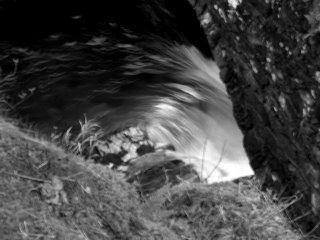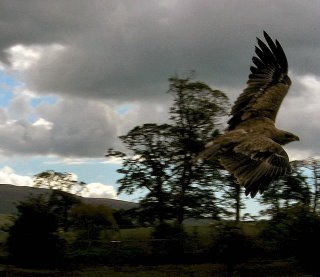Robert Macfarlane mentions briefly in his book The Wild Places of a ‘holloway near Bury St Edmunds’ that would be part of an old pilgrim path.
A holloway is a sunken path or road that centuries of use has eroded until it has become deeper than the level of the surrounding land. Some are Iron Age; some were the boundary ditches of Saxon farms and settlements. None are less than 300 years old.
I want to find the one that Macfarlane mentions. I want to see if I can walk it or enter it.
It isn’t marked on any current OS map so I visit the Council’s archaeological offices behind St Mary’s churchyard and am told that the probable location would be in Grindle, a ward to the south of Bury which takes its name from the open cast mining that used to take place there. Mining of what? I am told the holloway wouldn’t necessarily have been a pilgrim route as there were no such recognised routes to Bury, pilgrims would have followed market roads etc. like any other traveller
The other possible location is at Stanton, 5 miles or so north east of the town.
Nothing appears on the web either. In fact there are no references to holloways in Suffolk at all as far as I can see.
Perhaps I should contact Mr Macfarlane and see where his information comes from? He seems to be suggesting that this particular holloway is relatively well known, even a feature of the region. But the tourist office has never heard of it.
A mystery then.
Good.
The only other way to try to find it is to walk the land. Hazard guesses in there, follow my instinct, replay pilgrimages from different directions. Much more appealing, much more pertinent, solvent. So taking a good look at the satellite images on Google I find two possible locations to start: Grindle Gardens off Southgate and, further south, Hardwick Heath.
I leave at 3.50pm. It is a hot afternoon. The air barely shifts and the sun fair blazes.
On the small lawn in the quad behind the Norman Tower near St Mary’s churchyard, I find a pristine white doves feather. A remnant of the bird I saw nesting in the niche on the front of the tower in May. I pick it up and run my fingers along its length. It is perfect, unblemished. I keep it. It is hopeful. A dusky-skinned young tourist couple frolic and take photos of each other in front of the tower, posing in mock-medieval ecumenical stances, austere and learned, laughing at their high jinks.
At the top end of Southgate I veer off my planned route, taking a signposted Public Footpath east which would, I assume, lead round the back of Grindle Gardens and may throw up something far more interesting than the maze of new-build properties which has taken over this side of the road and of which Grindle Gardens is part. In any case, I suspect that any sign of the past has long been subsumed by contractors: Grindle only in name. I am in the vicinity which may be enough. This isn’t an exact science, but an unfolding, a peeling back in blissful ignorance.
So, along a dark fenced-off narrow and to the right of me there is an unkempt area of scrubland sandwiched between two arms of the new estate. Blackberry bushes with their sinewy thorns and brambles have taken over the area, twining upward into the lower branches of the surrounding trees. A pair of starlings gorge themselves on the earliest ripe fruits; they burble and wheeze to each other in constant communication. Whining, oscillating through numinous squeaks, clicks and wheezes. A jay glides unwarily across the scrub and almost lands in the tree just above me before it realises I am there and flies upward to come to rest unseen in the upper parts.
At the end of the narrow, I follow a pristine tarmac path round the back of Grindle Gardens. I don’t like it there, coming too close to the A1032 already, so I retrace my steps and take a left down a slight incline and I see there are algae covered pools on the right hand side almost hidden beneath the trees. The algae have riddled the water to such an extent that it looks almost solid, the only give away of liquid beneath are the numerous trails mallards leave in their wake as they all suddenly gravitate toward me. The juveniles are very curious and surprisingly fearless, one or two leaving the safety of the water to check me out while the rest continue to dabble at the algae. They are occasionally bumped by clumsy young moorhens as they in turn dive beneath the surface in attempts to forage.
A young kestrel spots for prey in the roadside verges atop a streetlamp beside the A1032, craning her neck, feathers ruffled by the breeze. Tourmaline eyes penetrating the undergrowth, before something unsettles her and she lifts off and flies skittishly away southward.
Cross the ring road and cut into the low-lying ground beyond, reeds and bulrushes and yet more brambles tower over me and the path is noticeably damp and muddy; below the water table then? I come out through the backs of yet more new-build housing, though this of a slightly older vintage than that at Grindle. I skirt through and find myself at an apex of three roads, one of which has an enormous and beautiful cedar tree at the corner, and the smell of humus-rich earth which I have to follow. The road has no footpath so I am forced to stop every few seconds as it is evidently a short-cut for traffic. In fact, I realise I haven’t yet met another walker out here. I reach a junction with a country lane that has a national speed limit sign tacked onto it which doesn’t bode well for further traverse by foot, particularly as the verge is too steep to access in a hurry in the face of oncoming traffic. I stop awhile determining what to do and rest on what remains of an old footbridge, the watercourse beneath it long since dried and gone, and overlooking a resplendent cornfield shimmering gold in the sun. Idyllic if it weren’t for the monotony of BMW’s and four-by-fours that suddenly seem to have erupted out of nowhere and all of whom are using this route out of Bury. I don’t really want to have to turn back. Besides I should be able, by my reckoning, to see my second destination, the Heath; and yet it remains elusive. I must have taken a wrong turn. I watch goldcrests and coal tits scurry around the upper branches of another cedar on the corner opposite. Cedar everywhere.
Wandering despondently back, negotiating the traffic and sleeping policemen. There is a road – Sharp Road – which leads off this arterial hell and I take it, geographically it is heading in the right direction for the Heath, so who knows. It winds through another estate, this time each house is large, ostentatious and utterly individual, evidently far more expensive than the others I’ve seen so far. At the far end I can see an open expanse of lush grazing field with sheep dotted here and there upon it, heads down and I am hopeful this is the Heath. Only to be let down as I get close and see there is a sign reading ‘Hardwick Manor Private Drive’. I rest on the fence, watching the sheep and trying to ascertain where the hell the heath is then, and when does this ownership of the land (both great and small) finally stop and give way to something approximating the countryside? Surely it hasn’t disappeared beneath building lots, or maybe the heath is owned by Lord or Lady of the manor and is not open to the public? When I turn to leave an overweight woman in her late thirties has come out of her house and is watching me suspiciously. When she sees me retracing my steps she scurries back into her house, head down. I feel like knocking on her door and asking what the hell she was watching me like that for? Did she think I was going to steal a sheep?
I make my way right back to the three road junction. Again that lovely, warm smell of cedar needles and must slowly rotting on the ground. Soft, delicate. But I’m feeling downhearted. I can’t even find the heath, let alone any sign of a possible location for the holloway and I’ve been walking for the better part of two hours. I take the only road left to me, the one of the three that I hadn’t already walked and pass in front of a hospital and take the first Public Footpath sign I see, which leads off alongside the hospital grounds and out onto the Heath! At last! But I’m disappointed. This isn’t the untouched southern breckland I was hoping for, but tended parkland with some wilder spaces – a football pitch, a fishing pond etc. the ubiquitous cedars. Even so, it holds some interest. There are twenty or so pied wagtails in the corner of the football field, chasing bugs and midges where the grass has been left to grow a little longer, they twitch and jump every so often or else sprint short distances to catch prey, and in amongst them there are goldfinch foraging for seed, their round fluting calls a giveaway.
I find a secluded and overgrown meadow set back away from the main drag and watch the sun go down through the long grass, teasels etc; shadows stretching beyond comprehension into the hedgerows and over tree boles. The smell in there is sweet and heady and for a moment I am lost. A spotted flycatcher darts from its perch on a crab apple tree. That’s enough, for now – what more could you want, in any case? I doze at the feet of three sister cedars, watch the sky, the high altitude gulls effortlessly cruising back to the sea for the night, the wood pigeons arcing and dive-bombing, the swifts showing off beautifully. Even so, I feel thwarted, let down by the fingers of development and man’s need to captivate the land, make it ready.
One thing to mention of note is that, from the heath, the cathedral (nee the Abbey in medieval times?) is clearly visible. If I were a pilgrim I’d be pleased at that.
Bury St Edmunds









